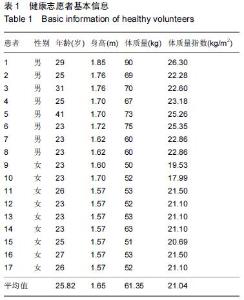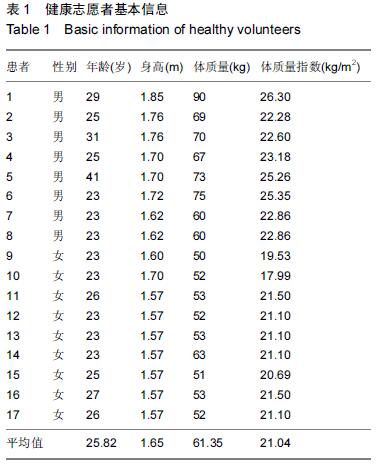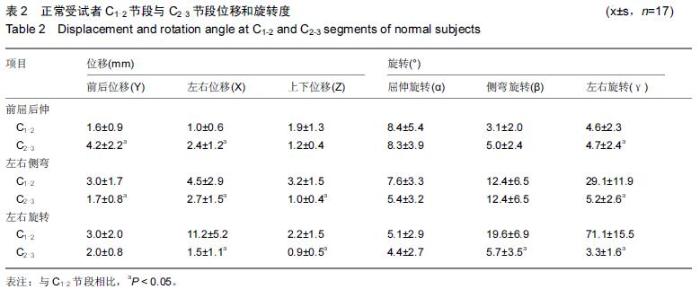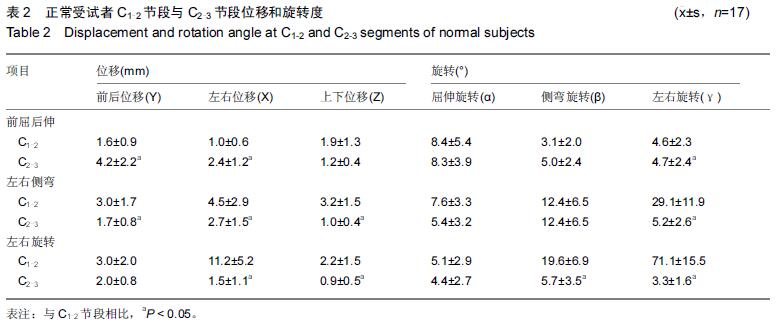Chinese Journal of Tissue Engineering Research ›› 2016, Vol. 20 ›› Issue (17): 2526-2532.doi: 10.3969/j.issn.2095-4344.2016.17.013
Previous Articles Next Articles
Three-dimensional transient motion characteristics of atlanto-axial joint in healthy adults under physiological load
Wei Dong1, 2, Xia Qun2, Miao Jun2, Bai Jian-qiang2, Liu Jia-nan2, Li Hong-da2
- 1Graduate School, Tianjin University of Traditional Chinese Medicine, Tianjin 300193, China; 2Second Ward, Department of Spinal Surgery, Tianjin Hospital, Tianjin 300162, China
-
Received:2016-02-06Online:2016-04-22Published:2016-04-22 -
Contact:Xia Qun, Professor, Chief physician, Second Ward, Department of Spinal Surgery, Tianjin Hospital, Tianjin 300162, China -
About author:Wei Dong, Studying for master’s degree, Physician, Graduate School, Tianjin University of Traditional Chinese Medicine, Tianjin 300193, China; Second Ward, Department of Spinal Surgery, Tianjin Hospital, Tianjin 300162, China -
Supported by:the National Natural Science Foundation of China, No. 81472140, 8157090604
Cite this article
Wei Dong, Xia Qun, Miao Jun, Bai Jian-qiang, Liu Jia-nan, Li Hong-da. Three-dimensional transient motion characteristics of atlanto-axial joint in healthy adults under physiological load[J]. Chinese Journal of Tissue Engineering Research, 2016, 20(17): 2526-2532.
share this article
|
[1] Wen N, Lavaste F, Santin JJ, et al. Three-dimensional biomechanical properties of the human cervical spine in vitro. II. Analysis of instability after ligamentous injuries. Eur Spine J. 1993;2(1):12-15. [2] Panjabi MM, Crisco JJ, Vasavada A, et al. Mechanical properties of the human cervical spine as shown by three-dimensional load-displacement curves. Spine (Phila Pa 1976). 2001;26(24):2692-2700. [3] Dugailly PM, Sobczak S, Sholukha V, et al. In vitro 3D-kinematics of the upper cervical spine: helical axis and simulation for axial rotation and flexion extension. Surg Radiol Anat. 2010;32(2):141-151. [4] Lee S, Harris KG, Nassif J, et al. In vivo kinematics of the cervical spine. Part I: Development of a roentgen stereophotogrammetric technique using metallic markers and assessment of its accuracy. J Spinal Disord. 1993;6(6):522-534. [5] Dvorak J, Hayek J, Zehnder R. CT-functional diagnostics of the rotatory instability of the upper cervical spine. Part 2. An evaluation on healthy adults and patients with suspected instability. Spine (Phila Pa 1976). 1987;12(8):726-731. [6] Kitagawa T, Fujiwara A, Kobayashi N, et al. Morphologic changes in the cervical neural foramen due to flexion and extension: in vivo imaging study. Spine (Phila Pa 1976). 2004;29(24):2821-2825. [7] Nagamoto Y, Iwasaki M, Sugiura T, et al. In vivo 3D kinematic changes in the cervical spine after laminoplasty for cervical spondylotic myelopathy. J Neurosurg Spine. 2014;21(3):417-424. [8] Lee JH, Kim JS, Lee JH, et al. Comparison of cervical kinematics between patients with cervical artificial disc replacement and anterior cervical discectomy and fusion for cervical disc herniation. Spine J. 2014;14(7):1199-1204. [9] Vorro J, Bush TR, Rutledge B, et al. Kinematic measures during a clinical diagnostic technique for human neck disorder: inter- and intraexaminer comparisons. Biomed Res Int. 2013;2013:950719. [10] Marin F, Hoang N, Aufaure P, et al. In vivo intersegmental motion of the cervical spine using an inverse kinematics procedure. Clin Biomech (Bristol, Avon). 2010;25(5):389-396. [11] Inokuchi H, Tojima M, Mano H, et al. Neck range of motion measurements using a new three-dimensional motion analysis system: validity and repeatability. Eur Spine J. 2015;24(12):2807-2815. [12] Anderst WJ, Donaldson WF 3rd, Lee JY, et al. Continuous cervical spine kinematics during in vivo dynamic flexion-extension. Spine J. 2014;14(7):1221-1227. [13] 夏群,Shaobai Wang,Guoan Li.腰椎椎体间旋转中心的在体研究[J].中华骨科杂志,2010,30(4):325-329. [14] Wang S, Passias P, Li G, et al. Measurement of vertebral kinematics using noninvasive image matching method-validation and application. Spine (Phila Pa 1976). 2008;33(11):E355-361. [15] 宁尚龙,夏群,苗军,等.腰椎间盘突出症椎体间在体运动的观察[J].中华骨科杂志,2012,32(5):393-397. [16] Lin CC, Lu TW, Wang TM, et al. In vivo three-dimensional intervertebral kinematics of the subaxial cervical spine during seated axial rotation and lateral bending via a fluoroscopy-to-CT registration approach. J Biomech. 2014;47(13):3310-3317. [17] 白剑强,夏群,闫广辉,等.腰椎椎弓根在体相对运动轨迹的研究[J].中华骨科杂志,2011,31(5):424-430. [18] 白剑强,夏群,苗军,等.双X线透视成像系统进行颈椎在体运动研究方法学的探索[J].医用生物力学,2012,27(2): 166-170,206. [19] Ishii T, Mukai Y, Hosono N, et al. Kinematics of the upper cervical spine in rotation: in vivo three-dimensional analysis. Spine (Phila Pa 1976). 2004;29(7):E139-144. [20] Ishii T, Mukai Y, Hosono N, et al. Kinematics of the cervical spine in lateral bending: in vivo three-dimensional analysis. Spine (Phila Pa 1976). 2006;31(2):155-160. [21] Nagamoto Y, Ishii T, Sakaura H, et al. In vivo three-dimensional kinematics of the cervical spine during head rotation in patients with cervical spondylosis. Spine (Phila Pa 1976). 2011;36(10): 778-783. [22] Takasaki H, Hall T, Oshiro S, et al. Normal kinematics of the upper cervical spine during the Flexion-Rotation Test - In vivo measurements using magnetic resonance imaging. Man Ther. 2011;16(2):167-171. [23] Salem W, Lenders C, Mathieu J, et al. In vivo three-dimensional kinematics of the cervical spine during maximal axial rotation. Man Ther. 2013;18(4): 339-444. [24] Zhao X, Wu ZX, Han BJ, et al. Three-dimensional analysis of cervical spine segmental motion in rotation. Arch Med Sci. 2013;9(3):515-520. [25] Li G, DeFrate LE, Park SE, et al. In vivo articular cartilage contact kinematics of the knee: an investigation using dual-orthogonal fluoroscopy and magnetic resonance image-based computer models. Am J Sports Med. 2005;33(1):102-107. [26] Wang S, Xia Q, Passias P, et al. Measurement of geometric deformation of lumbar intervertebral discs under in-vivo weightbearing condition. J Biomech. 2009;42(6):705-711. [27] Li G, Wang S, Passias P, et al. Segmental in vivo vertebral motion during functional human lumbar spine activities. Eur Spine J. 2009;18(7):1013-1021. [28] Wang S, Park WM, Kim YH, et al. In vivo loads in the lumbar L3-4 disc during a weight lifting extension. Clin Biomech (Bristol, Avon). 2014;29(2):155-160. [29] Miao J, Wang S, Wan Z, et al. Motion characteristics of the vertebral segments with lumbar degenerative spondylolisthesis in elderly patients. Eur Spine J. 2013; 22(2):425-431. [30] 胥鸿达,苗军,夏群.生理载荷下腰椎退变滑脱椎管容积的体内三维试验[J].中国组织工程研究,2014,18(53):8634-8640. [31] Wang S, Park WM, Gadikota HR, et al. A combined numerical and experimental technique for estimation of the forces and moments in the lumbar intervertebral disc. Comput Methods Biomech Biomed Engin. 2013; 16(12):1278-1286. [32] Shin JH, Wang S, Yao Q, et al. Investigation of coupled bending of the lumbar spine during dynamic axial rotation of the body. Eur Spine J. 2013;22(12): 2671-2677. [33] Yao Q, Wang S, Shin JH, et al. Lumbar facet joint motion in patients with degenerative spondylolisthesis. J Spinal Disord Tech. 2013;26(1):E19-27. [34] Li W, Wang S, Xia Q, et al. Lumbar facet joint motion in patients with degenerative disc disease at affected and adjacent levels: an in vivo biomechanical study. Spine (Phila Pa 1976). 2011;36(10):E629-637. [35] Xia Q, Wang S, Kozanek M, et al. In-vivo motion characteristics of lumbar vertebrae in sagittal and transverse planes. J Biomech. 2010;43(10):1905-1909. [36] Xia Q, Wang S, Passias PG, et al. In vivo range of motion of the lumbar spinous processes. Eur Spine J. 2009;18(9):1355-1362. [37] Anderst WJ, Donaldson WF 3rd, Lee JY, et al. Three-dimensional intervertebral kinematics in the healthy young adult cervical spine during dynamic functional loading. J Biomech. 2015;48(7):1286-1293.
|
| [1] | Zhang Tongtong, Wang Zhonghua, Wen Jie, Song Yuxin, Liu Lin. Application of three-dimensional printing model in surgical resection and reconstruction of cervical tumor [J]. Chinese Journal of Tissue Engineering Research, 2021, 25(9): 1335-1339. |
| [2] | Zeng Yanhua, Hao Yanlei. In vitro culture and purification of Schwann cells: a systematic review [J]. Chinese Journal of Tissue Engineering Research, 2021, 25(7): 1135-1141. |
| [3] | Xu Dongzi, Zhang Ting, Ouyang Zhaolian. The global competitive situation of cardiac tissue engineering based on patent analysis [J]. Chinese Journal of Tissue Engineering Research, 2021, 25(5): 807-812. |
| [4] | Wu Zijian, Hu Zhaoduan, Xie Youqiong, Wang Feng, Li Jia, Li Bocun, Cai Guowei, Peng Rui. Three-dimensional printing technology and bone tissue engineering research: literature metrology and visual analysis of research hotspots [J]. Chinese Journal of Tissue Engineering Research, 2021, 25(4): 564-569. |
| [5] | Chang Wenliao, Zhao Jie, Sun Xiaoliang, Wang Kun, Wu Guofeng, Zhou Jian, Li Shuxiang, Sun Han. Material selection, theoretical design and biomimetic function of artificial periosteum [J]. Chinese Journal of Tissue Engineering Research, 2021, 25(4): 600-606. |
| [6] | Liu Fei, Cui Yutao, Liu He. Advantages and problems of local antibiotic delivery system in the treatment of osteomyelitis [J]. Chinese Journal of Tissue Engineering Research, 2021, 25(4): 614-620. |
| [7] | Li Xiaozhuang, Duan Hao, Wang Weizhou, Tang Zhihong, Wang Yanghao, He Fei. Application of bone tissue engineering materials in the treatment of bone defect diseases in vivo [J]. Chinese Journal of Tissue Engineering Research, 2021, 25(4): 626-631. |
| [8] | Zhang Zhenkun, Li Zhe, Li Ya, Wang Yingying, Wang Yaping, Zhou Xinkui, Ma Shanshan, Guan Fangxia. Application of alginate based hydrogels/dressings in wound healing: sustained, dynamic and sequential release [J]. Chinese Journal of Tissue Engineering Research, 2021, 25(4): 638-643. |
| [9] | Chen Jiana, Qiu Yanling, Nie Minhai, Liu Xuqian. Tissue engineering scaffolds in repairing oral and maxillofacial soft tissue defects [J]. Chinese Journal of Tissue Engineering Research, 2021, 25(4): 644-650. |
| [10] | Xing Hao, Zhang Yonghong, Wang Dong. Advantages and disadvantages of repairing large-segment bone defect [J]. Chinese Journal of Tissue Engineering Research, 2021, 25(3): 426-430. |
| [11] | Li Kun, Li Zhijun, Zhang Shaojie, Gao Shang, Sun Hao, Yang Xi, Wang Xing, Dai Lina . A 4-year-old child model of occipito-atlanto-axial joints established by finite element dynamic simulation [J]. Chinese Journal of Tissue Engineering Research, 2021, 25(24): 3773-3778. |
| [12] | Chen Siqi, Xian Debin, Xu Rongsheng, Qin Zhongjie, Zhang Lei, Xia Delin. Effects of bone marrow mesenchymal stem cells and human umbilical vein endothelial cells combined with hydroxyapatite-tricalcium phosphate scaffolds on early angiogenesis in skull defect repair in rats [J]. Chinese Journal of Tissue Engineering Research, 2021, 25(22): 3458-3465. |
| [13] | Wang Hao, Chen Mingxue, Li Junkang, Luo Xujiang, Peng Liqing, Li Huo, Huang Bo, Tian Guangzhao, Liu Shuyun, Sui Xiang, Huang Jingxiang, Guo Quanyi, Lu Xiaobo. Decellularized porcine skin matrix for tissue-engineered meniscus scaffold [J]. Chinese Journal of Tissue Engineering Research, 2021, 25(22): 3473-3478. |
| [14] | Mo Jianling, He Shaoru, Feng Bowen, Jian Minqiao, Zhang Xiaohui, Liu Caisheng, Liang Yijing, Liu Yumei, Chen Liang, Zhou Haiyu, Liu Yanhui. Forming prevascularized cell sheets and the expression of angiogenesis-related factors [J]. Chinese Journal of Tissue Engineering Research, 2021, 25(22): 3479-3486. |
| [15] | Liu Chang, Li Datong, Liu Yuan, Kong Lingbo, Guo Rui, Yang Lixue, Hao Dingjun, He Baorong. Poor efficacy after vertebral augmentation surgery of acute symptomatic thoracolumbar osteoporotic compression fracture: relationship with bone cement, bone mineral density, and adjacent fractures [J]. Chinese Journal of Tissue Engineering Research, 2021, 25(22): 3510-3516. |
| Viewed | ||||||
|
Full text |
|
|||||
|
Abstract |
|
|||||



